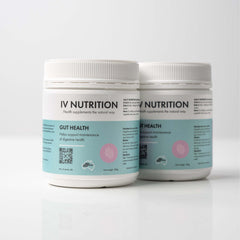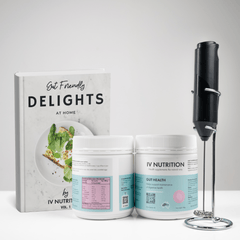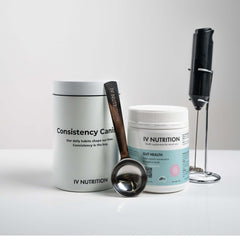Heartburn affects millions globally, with nearly 20% of adults in Western countries experiencing it weekly (NIH study). For some, it's an occasional discomfort; for others, it becomes a chronic condition that disrupts sleep, concentration, and quality of life. So the pressing question becomes: What is the strongest heartburn relief available—and is it sustainable long term?
This article will unpack that question with clinically backed research, break down the efficacy of over-the-counter (OTC) and prescription medications, and explore emerging strategies—including gut health optimization with prebiotic fibers—as part of a comprehensive approach to heartburn relief.
We’ll also introduce a groundbreaking natural solution that offers deep, cellular-level digestive support: IV Nutrition’s virgin-manufactured sugarcane prebiotic fiber, now available with 100% off your first tub when you subscribe via this link.
Understanding Heartburn: The Physiology Behind the Burn
Heartburn occurs when gastric acid refluxes back into the esophagus, often due to dysfunction of the lower esophageal sphincter (LES)—the valve that separates the stomach from the esophagus. When the LES weakens or relaxes inappropriately, acid escapes, irritating the sensitive esophageal lining.
Symptoms typically include:
-
A burning sensation in the chest or throat
-
Regurgitation of food or sour liquid
-
Bloating or a feeling of fullness
-
Chronic cough or throat irritation
Heartburn becomes gastroesophageal reflux disease (GERD) when it’s persistent (2 or more episodes per week) and starts affecting sleep, breathing, or swallowing.
What Is the Strongest Heartburn Relief?
The "strongest" relief depends on how fast it works, how long it lasts, and whether it addresses short-term symptoms or long-term causes. Let's examine the options from a clinical standpoint.
1. Proton Pump Inhibitors (PPIs): The Most Potent Pharmaceutical Option
PPIs are widely considered the most powerful acid reducers available. They block the enzyme in the stomach wall that produces acid, providing 24-hour suppression of gastric acid.
Common PPIs:
-
Omeprazole (Prilosec)
-
Esomeprazole (Nexium)
-
Pantoprazole (Protonix)
-
Lansoprazole (Prevacid)
How They Work:
PPIs irreversibly inhibit the H+/K+ ATPase enzyme system—also called the "proton pump"—in the parietal cells of the stomach.
Effectiveness:
Clinical studies show that PPIs heal esophagitis in 85%–95% of cases within 8 weeks (source). They are particularly effective for severe GERD and patients with erosive esophagitis.
Downsides:
-
Not ideal for long-term use
-
May impair nutrient absorption (B12, magnesium)
-
Associated with increased risk of infections, bone fractures, and kidney disease (Mayo Clinic)
2. H2 Receptor Antagonists (H2 Blockers): Moderate Relief, Fewer Side Effects
These drugs block histamine receptors on stomach cells to reduce acid production. They're not as potent as PPIs but still offer significant relief.
Common H2 Blockers:
-
Famotidine (Pepcid)
-
Ranitidine (withdrawn from market due to safety concerns)
Effectiveness:
H2 blockers are effective for mild to moderate reflux and are faster-acting than PPIs (typically 30–60 minutes).
Clinical Evidence:
A double-blind, placebo-controlled study published in Alimentary Pharmacology & Therapeutics found that famotidine significantly reduced heartburn symptoms within the first hour of ingestion (study link).
3. Antacids: Instant but Short-Term Relief
These neutralize stomach acid on contact and work within minutes, making them ideal for occasional heartburn.
Examples:
-
Calcium carbonate (Tums)
-
Magnesium hydroxide (Milk of Magnesia)
-
Aluminum hydroxide (Maalox)
Limitations:
-
Short duration (1–2 hours)
-
Not a solution for chronic or recurring reflux
4. Alginates: A Barrier-Based Approach
Derived from seaweed, alginates create a foam raft that floats on top of stomach contents, forming a physical barrier that prevents reflux.
Clinical Insight:
A 2012 study in Journal of the American Medical Association found alginate therapy to be effective when used alongside PPIs, especially in nighttime reflux (study link).
So, What’s the Strongest Heartburn Relief?
For acute, severe symptoms: PPIs offer the strongest pharmaceutical relief.
For occasional discomfort: Antacids or H2 blockers are fast and effective.
But for sustainable, long-term relief, the strongest heartburn solution isn’t a drug—it’s fixing the gut itself.
Gut Health and Reflux: The Missing Piece of the Puzzle
Emerging research underscores the role of the gut microbiome in managing acid reflux and GERD. Imbalanced gut flora can lead to:
-
Increased gastric pressure from gas-producing bacteria
-
Slower gastric emptying
-
Compromised mucosal barriers
-
Heightened inflammation in the esophagus
A study published in Gut Microbes identified a clear link between gut dysbiosis and GERD symptoms (read the full study).
So, if acid suppression treats the symptom, restoring the gut addresses the cause.
The Power of Prebiotic Fiber: A Natural Long-Term Solution
What Are Prebiotics?
Prebiotics are indigestible fibers that feed beneficial gut bacteria. Unlike probiotics, which introduce new bacteria into your system, prebiotics help your existing microbiota flourish, improving digestive balance and reducing reflux triggers.
How Prebiotics Help Soothe Heartburn:
-
Improve gastric motility, preventing acid buildup
-
Reduce esophageal inflammation
-
Strengthen gut mucosal lining
-
Balance pH levels in the digestive tract
-
Prevent overgrowth of gas-producing bacteria
Why Sugarcane-Based Prebiotic Fiber from IV Nutrition Stands Out
Among available prebiotic options, IV Nutrition’s virgin-manufactured sugarcane prebiotic fiber is one of the cleanest, most potent natural gut-balancing tools available today.
What Sets It Apart:
-
100% natural and organic: Derived from unprocessed sugarcane
-
Virgin-manufactured: Minimally processed to preserve bioactive fibers
-
High in soluble fiber: Supports a smoother, gentler digestive process
-
Free from additives, preservatives, and synthetics
When paired with a reflux-friendly diet and lifestyle, this prebiotic fiber offers lasting digestive resilience that pharmaceuticals can’t match.
Special Offer: Get 100% off your first tub when you subscribe using this link.
Clinical Benefits at a Glance
| Benefit | Scientific Relevance |
|---|---|
| Reduces LES pressure and bloating | Less strain on reflux barrier |
| Promotes butyrate production | Enhances gut lining repair and reduces inflammation |
| Supports probiotic diversity | Rebalances microbiome linked to reflux |
| Improves stool regularity | Relieves abdominal pressure that contributes to GERD |
Real-Life Application: Building a Heartburn-Resistant Gut
Here’s how you can incorporate this prebiotic strategy into your reflux management plan:
Morning: Mix one scoop of IV Nutrition sugarcane fiber into warm (not hot) water or caffeine-free tea like ginger or chamomile.
Midday: Eat a gut-friendly lunch with high-fiber vegetables, lean protein, and healthy fats.
Evening: Avoid large meals and opt for fermented foods (like kefir or sauerkraut) alongside a light prebiotic-rich drink.
This combination builds gut integrity while protecting your esophagus from acid flare-ups.
Other Clinically Supported Natural Remedies
1. Melatonin
Shown to strengthen the LES and reduce nighttime reflux, melatonin may be as effective as PPIs in some cases (BMC Gastroenterology).
2. Ginger Root
Ginger has anti-inflammatory and pro-kinetic effects. A small trial in World Journal of Gastroenterology showed reduced gastric emptying time, which is beneficial in GERD management (source).
3. Chamomile Tea
Soothes both the esophagus and central nervous system—reducing stress-related reflux. Avoid lemon or sweeteners.
4. DGL Licorice
Deglycyrrhizinated licorice stimulates mucus production, coating and protecting the esophageal lining. It’s best taken before meals.
Pharmaceutical vs. Nutritional Relief: A Clinical Comparison
| Approach | Mechanism | Duration | Ideal For |
|---|---|---|---|
| PPIs | Blocks acid production | Long-term (Rx) | Erosive esophagitis, chronic GERD |
| H2 Blockers | Reduces acid secretion | 6–12 hours | Mild/moderate reflux |
| Antacids | Neutralizes existing acid | 1–2 hours | Occasional heartburn |
| Prebiotic Fiber (IV Nutrition) | Rebalances gut microbiota and pH | Ongoing | Long-term healing and prevention |
| Alginates | Physical barrier to reflux | 4–6 hours | Post-meal/night reflux |
Conclusion: The Strongest Heartburn Relief Is a Holistic Approach
When it comes to stopping heartburn in its tracks, PPIs provide the strongest immediate pharmaceutical relief. But the real power lies in treating the root causes, not just the symptoms.
That means restoring your gut microbiome, improving digestion, and strengthening the body’s natural defenses against acid overload.
Prebiotic fiber—especially the clean, clinically effective sugarcane blend from IV Nutrition—offers sustainable, evidence-based support for your digestive system.
Start with 100% off your first tub when you subscribe, and build a foundation for digestive peace that medication alone can’t deliver.





